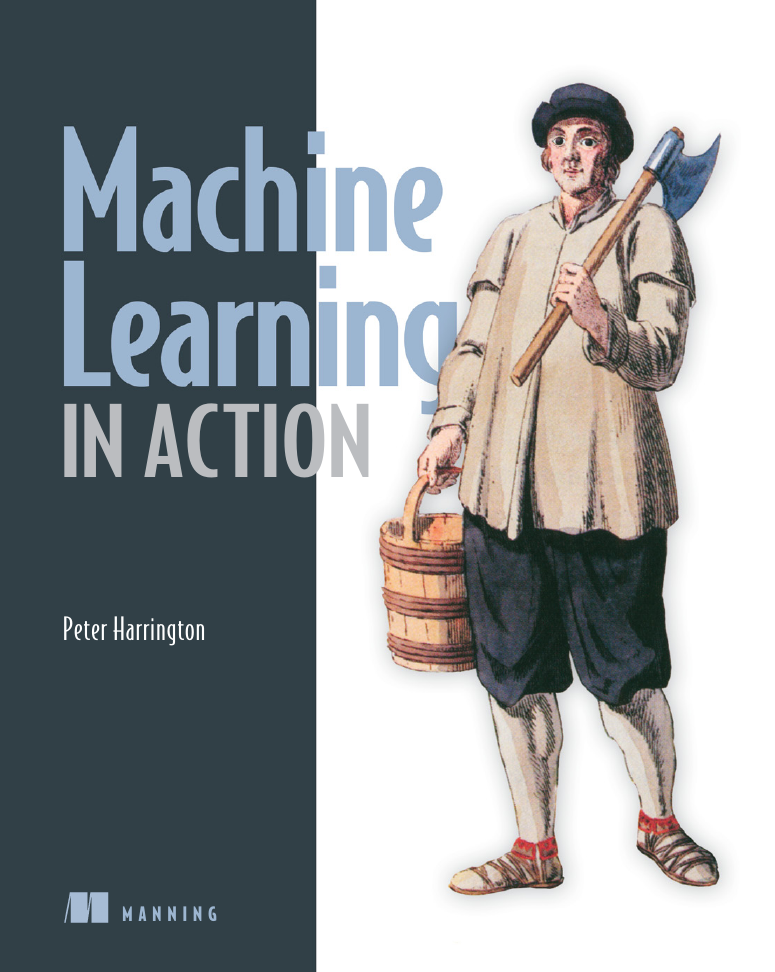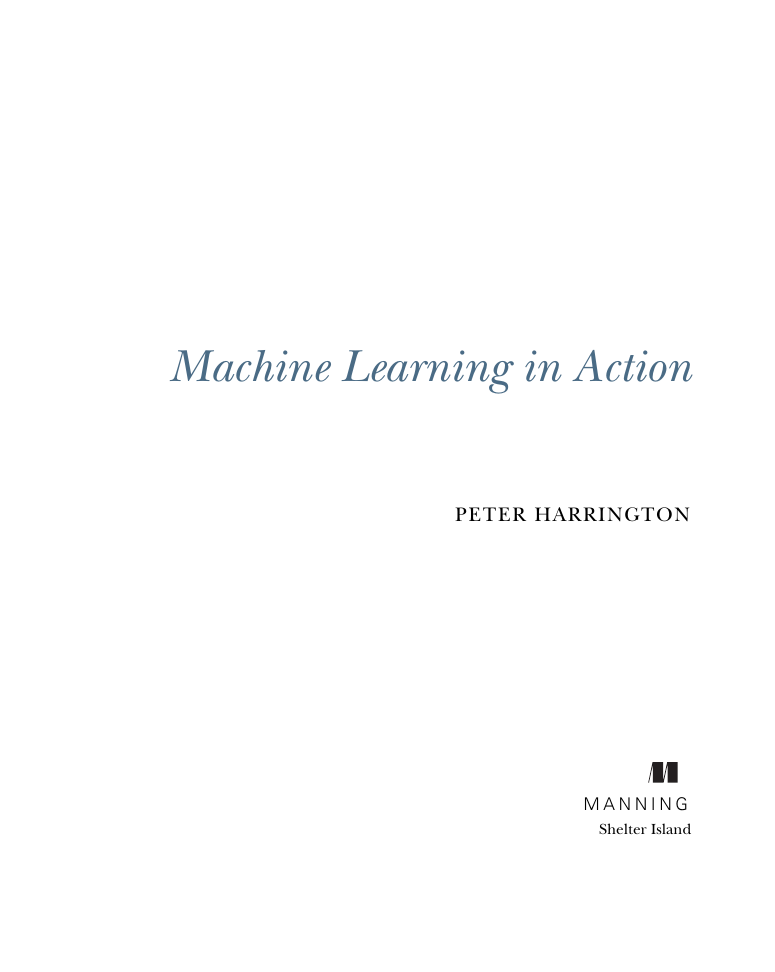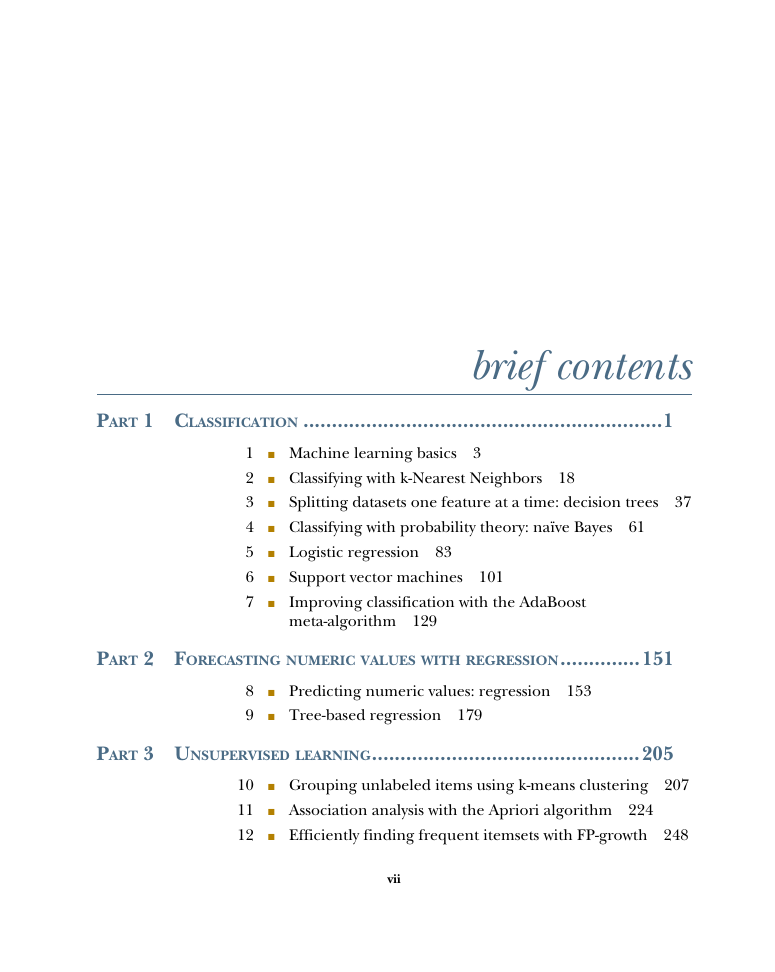Machine Learning in Action
brief contents
contents
preface
acknowledgments
about this book
Audience
Top 10 algorithms in data mining
How the book is organized
Part 1 Machine learning basics
Part 2 Forecasting numeric values with regression
Part 3 Unsupervised learning
Part 4 Additional tools
Examples
Code conventions and downloads
Author Online
about the author
about the cover illustration
Classification
Machine learning basics
1.1 What is machine learning?
1.1.1 Sensors and the data deluge
1.1.2 Machine learning will be more important in the future
1.2 Key terminology
1.3 Key tasks of machine learning
1.4 How to choose the right algorithm
1.5 Steps in developing a machine learning application
1.6 Why Python?
1.6.1 Executable pseudo-code
1.6.2 Python is popular
1.6.3 What Python has that other languages don’t have
1.6.4 Drawbacks
1.7 Getting started with the NumPy library
1.8 Summary
Classifying with k-Nearest Neighbors
2.1 Classifying with distance measurements
2.1.1 Prepare: importing data with Python
2.1.2 Putting the kNN classification algorithm into action
2.1.3 How to test a classifier
2.2 Example: improving matches from a dating site with kNN
2.2.1 Prepare: parsing data from a text file
2.2.2 Analyze: creating scatter plots with Matplotlib
2.2.3 Prepare: normalizing numeric values
2.2.4 Test: testing the classifier as a whole program
2.2.5 Use: putting together a useful system
2.3 Example: a handwriting recognition system
2.3.1 Prepare: converting images into test vectors
2.3.2 Test: kNN on handwritten digits
2.4 Summary
Splitting datasets one feature at a time: decision trees
3.1 Tree construction
3.1.1 Information gain
3.1.2 Splitting the dataset
3.1.3 Recursively building the tree
3.2 Plotting trees in Python with Matplotlib annotations
3.2.1 Matplotlib annotations
3.2.2 Constructing a tree of annotations
3.3 Testing and storing the classifier
3.3.1 Test: using the tree for classification
3.3.2 Use: persisting the decision tree
3.4 Example: using decision trees to predict contact lens type
3.5 Summary
Classifying with probability theory: naïve Bayes
4.1 Classifying with Bayesian decision theory
4.2 Conditional probability
4.3 Classifying with conditional probabilities
4.4 Document classification with naïve Bayes
4.5 Classifying text with Python
4.5.1 Prepare: making word vectors from text
4.5.2 Train: calculating probabilities from word vectors
4.5.3 Test: modifying the classifier for real-world conditions
4.5.4 Prepare: the bag-of-words document model
4.6 Example: classifying spam email with naïve Bayes
4.6.1 Prepare: tokenizing text
4.6.2 Test: cross validation with naïve Bayes
4.7 Example: using naïve Bayes to reveal local attitudes from personal ads
4.7.1 Collect: importing RSS feeds
4.7.2 Analyze: displaying locally used words
4.8 Summary
Logistic regression
5.1 Classification with logistic regression and the sigmoid function: a tractable step function
5.2 Using optimization to find the best regression coefficients
5.2.1 Gradient ascent
5.2.2 Train: using gradient ascent to find the best parameters
5.2.3 Analyze: plotting the decision boundary
5.2.4 Train: stochastic gradient ascent
5.3 Example: estimating horse fatalities from colic
5.3.1 Prepare: dealing with missing values in the data
5.3.2 Test: classifying with logistic regression
5.4 Summary
Support vector machines
6.1 Separating data with the maximum margin
6.2 Finding the maximum margin
6.2.1 Framing the optimization problem in terms of our classifier
6.2.2 Approaching SVMs with our general framework
6.3 Efficient optimization with the SMO algorithm
6.3.1 Platt’s SMO algorithm
6.3.2 Solving small datasets with the simplified SMO
6.4 Speeding up optimization with the full Platt SMO
6.5 Using kernels for more complex data
6.5.1 Mapping data to higher dimensions with kernels
6.5.2 The radial bias function as a kernel
6.5.3 Using a kernel for testing
6.6 Example: revisiting handwriting classification
6.7 Summary
Improving classification with the AdaBoost meta-algorithm
7.1 Classifiers using multiple samples of the dataset
7.1.1 Building classifiers from randomly resampled data: bagging
7.1.2 Boosting
7.2 Train: improving the classifier by focusing on errors
7.3 Creating a weak learner with a decision stump
7.4 Implementing the full AdaBoost algorithm
7.5 Test: classifying with AdaBoost
7.6 Example: AdaBoost on a difficult dataset
7.7 Classification imbalance
7.7.1 Alternative performance metrics: precision, recall, and ROC
7.7.2 Manipulating the classifier’s decision with a cost function
7.7.3 Data sampling for dealing with classification imbalance
7.8 Summary
Forecasting numeric values with regression
Predicting numeric values: regression
8.1 Finding best-fit lines with linear regression
8.2 Locally weighted linear regression
8.3 Example: predicting the age of an abalone
8.4 Shrinking coefficients to understand our data
8.4.1 Ridge regression
8.4.2 The lasso
8.4.3 Forward stagewise regression
8.5 The bias/variance tradeoff
8.6 Example: forecasting the price of LEGO sets
8.6.1 Collect: using the Google shopping API
8.6.2 Train: building a model
8.7 Summary
Tree-based regression
9.1 Locally modeling complex data
9.2 Building trees with continuous and discrete features
9.3 Using CART for regression
9.3.1 Building the tree
9.3.2 Executing the code
9.4 Tree pruning
9.4.1 Prepruning
9.4.2 Postpruning
9.5 Model trees
9.6 Example: comparing tree methods to standard regression
9.7 Using Tkinter to create a GUI in Python
9.7.1 Building a GUI in Tkinter
9.7.2 Interfacing Matplotlib and Tkinter
9.8 Summary
Unsupervised learning
Grouping unlabeled items using k-means clustering
10.1 The k-means clustering algorithm
10.2 Improving cluster performance with postprocessing
10.3 Bisecting k-means
10.4 Example: clustering points on a map
10.4.1 The Yahoo! PlaceFinder API
10.4.2 Clustering geographic coordinates
10.5 Summary
Association analysis with the Apriori algorithm
11.1 Association analysis
11.2 The Apriori principle
11.3 Finding frequent itemsets with the Apriori algorithm
11.3.1 Generating candidate itemsets
11.3.2 Putting together the full Apriori algorithm
11.4 Mining association rules from frequent item sets
11.5 Example: uncovering patterns in congressional voting
11.5.1 Collect: build a transaction data set of congressional voting records
11.5.2 Test: association rules from congressional voting records
11.6 Example: finding similar features in poisonous mushrooms
11.7 Summary
Efficiently finding frequent itemsets with FP-growth
12.1 FP-trees: an efficient way to encode a dataset
12.2 Build an FP-tree
12.2.1 Creating the FP-tree data structure
12.2.2 Constructing the FP-tree
12.3 Mining frequent items from an FP-tree
12.3.1 Extracting conditional pattern bases
12.3.2 Creating conditional FP-trees
12.4 Example: finding co-occurring words in a Twitter feed
12.5 Example: mining a clickstream from a news site
12.6 Summary
Additional tools
Using principal component analysis to simplify data
13.1 Dimensionality reduction techniques
13.2 Principal component analysis
13.2.1 Moving the coordinate axes
13.2.2 Performing PCA in NumPy
13.3 Example: using PCA to reduce the dimensionality of semiconductor manufacturing data
13.4 Summary
Simplifying data with the singular value decomposition
14.1 Applications of the SVD
14.1.1 Latent semantic indexing
14.1.2 Recommendation systems
14.2 Matrix factorization
14.3 SVD in Python
14.4 Collaborative filtering–based recommendation engines
14.4.1 Measuring similarity
14.4.2 Item-based or user-based similarity?
14.4.3 Evaluating recommendation engines
14.5 Example: a restaurant dish recommendation engine
14.5.1 Recommending untasted dishes
14.5.2 Improving recommendations with the SVD
14.5.3 Challenges with building recommendation engines
14.6 Example: image compression with the SVD
14.7 Summary
Big data and MapReduce
15.1 MapReduce: a framework for distributed computing
15.2 Hadoop Streaming
15.2.1 Distributed mean and variance mapper
15.2.2 Distributed mean and variance reducer
15.3 Running Hadoop jobs on Amazon Web Services
15.3.1 Services available on AWS
15.3.2 Getting started with Amazon Web Services
15.3.3 Running a Hadoop job on EMR
15.4 Machine learning in MapReduce
15.5 Using mrjob to automate MapReduce in Python
15.5.1 Using mrjob for seamless integration with EMR
15.5.2 The anatomy of a MapReduce script in mrjob
15.6 Example: the Pegasos algorithm for distributed SVMs
15.6.1 The Pegasos algorithm
15.6.2 Training: MapReduce support vector machines with mrjob
15.7 Do you really need MapReduce?
15.8 Summary
appendix A: Getting started with Python
A.1 Installing Python
A.1.1 Windows
A.1.2 Mac OS X
A.1.3 Linux
A.2 A quick introduction to Python
A.2.1 Collection types
A.2.2 Control structures
A.2.3 List comprehensions
A.3 A quick introduction to NumPy
A.4 Beautiful Soup
A.5 Mrjob
A.6 Vote Smart
A.7 Python-Twitter
appendix B: Linear algebra
B.1 Matrices
B.2 Matrix inverse
B.3 Norms
B.4 Matrix calculus
appendix C: Probability refresher
C.1 Intro to probability
C.2 Joint probability
C.3 Basic rules of probability
appendix D: Resources
index
Numerics
A
B
C
D
E
F
G
H
I
J
K
L
M
N
O
P
R
S
T
U
V
W
X
Y
















 2023年江西萍乡中考道德与法治真题及答案.doc
2023年江西萍乡中考道德与法治真题及答案.doc 2012年重庆南川中考生物真题及答案.doc
2012年重庆南川中考生物真题及答案.doc 2013年江西师范大学地理学综合及文艺理论基础考研真题.doc
2013年江西师范大学地理学综合及文艺理论基础考研真题.doc 2020年四川甘孜小升初语文真题及答案I卷.doc
2020年四川甘孜小升初语文真题及答案I卷.doc 2020年注册岩土工程师专业基础考试真题及答案.doc
2020年注册岩土工程师专业基础考试真题及答案.doc 2023-2024学年福建省厦门市九年级上学期数学月考试题及答案.doc
2023-2024学年福建省厦门市九年级上学期数学月考试题及答案.doc 2021-2022学年辽宁省沈阳市大东区九年级上学期语文期末试题及答案.doc
2021-2022学年辽宁省沈阳市大东区九年级上学期语文期末试题及答案.doc 2022-2023学年北京东城区初三第一学期物理期末试卷及答案.doc
2022-2023学年北京东城区初三第一学期物理期末试卷及答案.doc 2018上半年江西教师资格初中地理学科知识与教学能力真题及答案.doc
2018上半年江西教师资格初中地理学科知识与教学能力真题及答案.doc 2012年河北国家公务员申论考试真题及答案-省级.doc
2012年河北国家公务员申论考试真题及答案-省级.doc 2020-2021学年江苏省扬州市江都区邵樊片九年级上学期数学第一次质量检测试题及答案.doc
2020-2021学年江苏省扬州市江都区邵樊片九年级上学期数学第一次质量检测试题及答案.doc 2022下半年黑龙江教师资格证中学综合素质真题及答案.doc
2022下半年黑龙江教师资格证中学综合素质真题及答案.doc